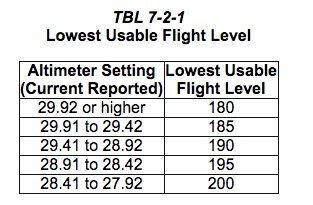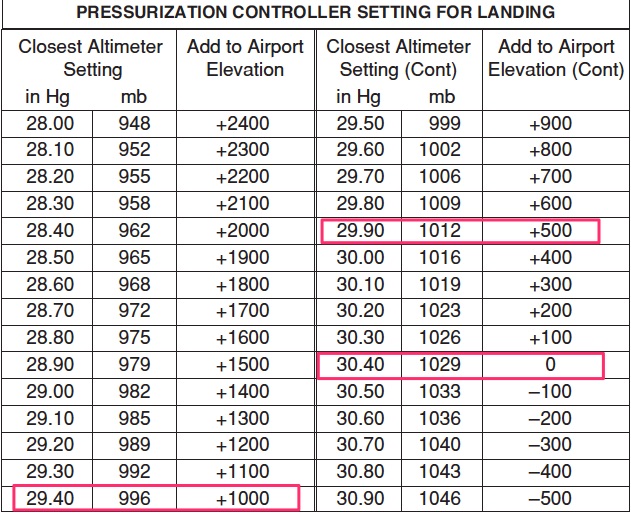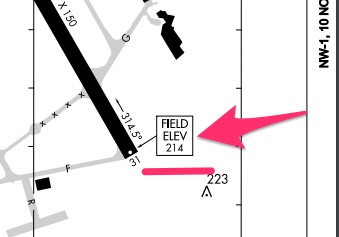
What is the procedure for setting the altimeter while flying? It’s a great question, and can be confusing even to experienced pilots.
I will break it down two sections: VFR and IFR as each have their own procedures. And, as always, I will provide links to additional articles at the end.
So let’s begin with the easy part:
IFR altimeter setting procedures:
Above FL180 (in the US…Europe is different but the same concept applies)
It’s really simple. As you approach flight level 180: set it to “Standard” or 29.92.
Likewise on the descent, set it for your destination’s altimeter setting as you descend through FL180.
I don’t get caught up in setting it exactly at 18,000 feet. It’s really not important, and if someone yells at you for setting it early or a little late, then make sure the next time you fly with that jerk you do it right at 18,000 feet. Not because it’s unsafe, but because it’s best to avoid conflict in the cockpit.
Horizon Airlines recently changed their checklist from setting it at 18,000 feet to “approaching 180.” They left “approaching” up to interpretation. I think that’s super sensible. Ultimately you decide, just don’t be a jerk about it.
Your cruise or 18,000 foot checklist should have “altimeter” in it. If it doesn’t, add it to your checklist. You will be surprised how many times you will forget it.
Note: I assume you already have the ATIS/ASOS info before you descend through FL180. If you don’t have ATIS by FL180, you are probably behind the power curve. But don’t worry, if you don’t have it yet, then approach or center will usually give you the altimeter setting. Use that in the absence of ATIS. Sometimes ATIS changes over around 55 past the hour which coincides with when you start your descent. Just set it later.
Below 180 flying IFR
The basic rule still applies to pilots flying below 180 on an IFR flight plan:
Set the altimeter setting when you get ATIS.
During your flight, when you are still too far out to get ATIS, change it when ATC gives you a new altimeter, which they will along your flight.
It’s simple. Don’t think too hard about it. Sure, you may pass by three other airports on the way. Who cares. You are probably at a safe altitude and under radar contact. If you are close enough to get ATIS on your radio you are close enough where the altimeter settings in the area will all be quite close to each other.
ATC has minimum safe vectoring altitudes. If you are under control of ATC, a 50 foot difference will not mean life or death which is why they are okay with you changing your altimeter so far out. Don’t take it upon yourself to dial-up a close airport and change your altimeter to the nearest airport especially under radar contact. It just doesn’t matter.
There are some areas in the Western US and Alaska that don’t have radar coverage. I do recommend you dial-up the nearest altimeter on a long cross-country every 100NM…if ATC doesn’t give you updated altimeter settings. This is especially true when you are within 2000 feet of terrain.
Note: During flight planning, remember certain altimeter settings will dictate your planned en-route altitude. Check it out:

What if I already set my destination’s ATIS and ATC gives me an altimeter setting that’s different?
You will see this situation every once in a while. I ran into it today flying into Bellingham, WA. Widby approach gave me their altimeter setting which was substantially different than KBLI’s.
What did I do? I kept my altimeter setting to my destination’s altimeter, not the altimeter setting ATC gave me.
I was already descending and I didn’t want to have to re-set it when they handed me off to the next controller which I knew they would in a couple of minutes.
Is this right? I don’t care, really. My destination’s altimeter is the MOST important number. ATC may give you a couple altimeter settings between the time you get ATIS and get to your destination below FL180. I find it simpler to just set it and forget it. It’s an unnecessary distraction at a critical phase of flight.
Ultimately, you decide. As an IFR pilot, you will run into that situation so decide how you want to handle it before hand.
Note for pressurized aircraft: you need to keep an eye on the altimeter setting for a different reason. Large pressure variations from standard means you may need to alter how many hundreds of feet you set the pressure controller to.
Generally you set the pressurization controller to 500 feet above the airport altitude (unless you have a more advanced system). However, with high or low pressure settings you may either set it 900 feet above or maybe only 100 feet or at airport altitude.
For example, when the pressure drops to 29.40 instead of setting 500 feet above the airport elevation you need to set 1000 feet above the airport elevation. The massive drop in pressure cancelled out the correction you made.
Check out this pressure variation chart from the King Air 350’s checklist:

Okay, now to the hard part:
VFR altimeter settings
There are several scenarios VFR pilots may fall into and your situation will dictate what you do.
As a general rule: once you get your destination’s ATIS, set your altimeter.
Please understand the altimeter exists to alert you to your altitude. If you can see the ground, you could have a broken altimeter, and you still won’t smack into the ground.
This is not cart blanche for you to run out and fly around with a broken altimeter which is illegal! I just want to point out, you don’t need to obsessively set the altimeter to every airport you pass. Relax! you won’t crash under VFR if your altimeter is 100 feet off. At some point your eyes would tell you are way too low and should do something about it. When in doubt look outside! You’re VFR.
Read this article, though, about a VFR pilot who didn’t stay VFR with a bad altimeter setting and it cost him his life: “Current altimeter settings really matter” by AOPA.
VFR pilots practicing IFR approaches
Here’s my personal opinion: if you are flying around VFR practicing IFR approaches, act like you would on an IFR flight and set the altimeter when you get your “destination’s” weather.
It’s what you would do on a real IFR flight plan, so, as we say in the Army: “train how you fight.”
If you pass three airports on the way to your practice IFR airport, you don’t need to dial-up every ATIS along the way and change your setting. Like I said earlier, you may be off a bit, but you are VFR, you aren’t going to crash into terrain because one airport’s setting is 30.10 and you took off with a 29.93 setting.
VFR pilots on long cross-country flights
Before you take off, you should do a look at your departure and destination’s altimeter setting. Are they off by a lot? Are you crossing a lot of terrain, at night? Night flying in bad weather makes the altimeter setting extremely important.
Here is what the FAR says about altimeter settings blow FL180:

Or, if you get flight following, ATC will give you the nearest altimeter setting every once in a while which is a benefit to flight following.
VFR pilots staying in the local area
Use the altimeter setting of the airport you are doing traffic patterns to. If you go to the next airport, then set that altimeter when you get the “one minute weather” (ASOS) or the ATIS at your new airport.
Teaching tangent: Before you takeoff on an IFR (and I recommend VFR) flight you should always check to make sure your altimeter is healthy. You do that by comparing the field elevation with the altimeter setting.
So on run up, set your altimeter to the official field elevation. That number should be pretty close to the official altimeter setting. When you get the ATIS and set the official altimeter setting, watch how much it changes. There shouldn’t be more than a 75 foot variation between the current altimeter setting and the field elevation.
You can find the official field elevation on the airport diagram. Check it out:

Yes…I know the regs are very confusing about this 75 foot rule. This rule doesn’t apply to VFR pilots, except it kind of does because your altimeter must be within 75′ when it gets checked under Part 43. See this from the Appendix E to Part 43

I recommend you adopt the 75 foot practice regardless of VFR/IFR status.
That’s it! I hope it’s clear as mud what you should do. As I do with all my posts, here are some additional articles you can read:
PDF on altimeter settings from Angel Flight NE
Comprehensive article from the FAA on altimeter settings
Article highlighting accidents caused by unusual altimeter settings the crew didn’t anticipate
A forum thread on altimeter errors for IFR flight
Hey! One more thing!
Did you like this article? I email my readers every week with more articles and aviation tips just like this. The thing is, these aviation tips aren’t on my blog! You can only get them by subscribing.
Still don’t want to join my email list? That’s okay. You can still download a FREE Ultimate Guide to Decoding NOTAMs below. You can unsubscribe after you downloaded the checklist. I don’t mind, seriously! I’m here to help.